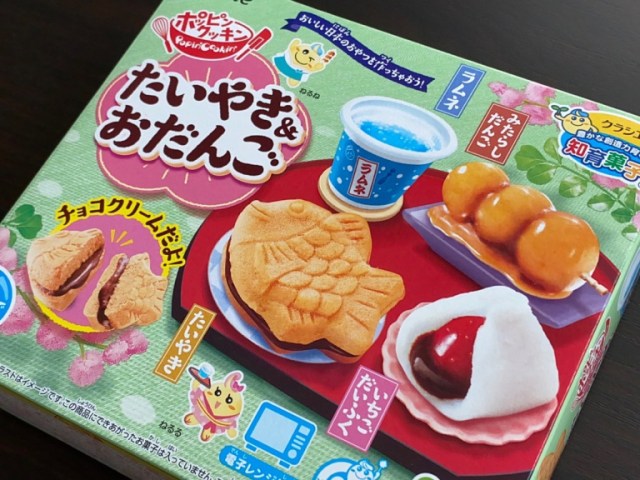
We made an entire Japanese sweets spread on our own with just one kit!
It’s fall, which means it’s the season for eating delicious, warm anko (red bean paste) and mochi treats. And what better way to enjoy them than to make them at home yourself and eat them fresh?
With Popin Cooking’s Taiyaki and Odango kit, you can make your own Japanese wagashi sweets at home without any specialized equipment. The 300-yen (US$2.85) kit comes with everything you need to make four delicious Japanese treats: chocolate cream taiyaki, strawberry daifuku (a strawberry wrapped in anko and mochi), mitarashi dango (mochi balls on a stick covered in salty-sweet sauce), and, of course, ramune.
Here’s everything that came in the box. All of the food starts off in powder form, which is not entirely unexpected, but still mysterious, since all you have to do is add water to everything to make the sweets. How does one make all four of those different things from powders?
We did find it nice that they actually included just about everything we needed but the microwave oven. The kit even came with a toothpick and a 2-mililiter (0.4 teaspoon) plastic measuring spoon!
Without much delay, we began our cooking experiment. We started with the strawberry daifuku. Both parts simply required us to mix their respective powders with water, including the “strawberry”.
What was surprising was that the two powders reacted completely differently when mixed with water. One powder turned into a smooth liquid, while the other turned out to have the elasticity of rubber. The power of science is amazing!
After mixing the powder with water, the next step was to knead the mochi substance with our hands thirty times. Time to get down and dirty.
Well, not that dirty, we guess.
After that we separated it into four parts–one for the daifuku, and three for the dango. It did look surprisingly mochi-like, despite being made of a mysterious powder and water.
Next we made the taiyaki! It’s not really a traditional taiyaki cake batter, since it’s usually made with eggs and milk, not just water.
After a short spurt in the microwave, though, they came out of the mold looking pretty good!
They smelled very sweet and were much softer and fluffier that typical taiyaki, more like chiffon cake, but they looked pretty tasty either way! Once they were cool, we added the chocolate cream, which looked a bit like anko red bean paste, to the reverse side of one and sandwiched them together.
Then we returned to the daifuku. On the mochi-like substance, we placed a dollop of anko-like chocolate topping, on top of which we placed a strawberry-like jelly…
And then rolled it up, and voila! Daifuku.
The next step was to skewer the dango, using the toothpick…that we had just used to scoop up the strawberry-like creation. It was pretty sticky from that…but oh well. We were the only ones eating this anyway.
The sauce for the mitarashi dango was next, and it looked surprisingly real. While the anko came out a little dark, this sauce–which was also made with powder and water–had the right level of translucence and shine, and the right color.
Lastly, after pouring the mitarashi sauce over the dango, it was time to make the ramune. This, too, of course, was produced from a powder and–you guessed it–water. But it was kind of exciting because once the powder hit the water, it instantly became fizzy.
Finished! We used the provided cardboard tray to arrange everything, since it had each sweet’s place printed on it. It looked pretty good, actually!
Aside from having to knead the mochi with our hands, it was really easy to make this wagashi spread! I know, I know…it’s been said a hundred times already but…it’s really as simple as mixing the powder with water.
But of course the most important thing is whether or not it tastes good, so we had to take a bite out of each one!
The ramune tasted…kind of synthetic. It’s probably the same powder ramune you can buy at the candy shop, the one where you just have to add water to make it into a drink. It’s not bad, but bottled liquid ramune is much better.
The mitarashi dango were surprisingly authentic! The sauce had a the prefect salty-sweet soy sauce flavor that it should have. It’s really impressive that you could make this so easily and from such simple ingredients. They should send this to the astronauts in space!
The strawberry daifuku and taiyaki were pretty heavy on the chocolate flavoring. We were honestly more impressed by the fact that the jelly-like strawberry and the sticky mochi were made the same way but had completely different textures and constitutions.
Overall, we had a great time with Popin Cooking’s “Taiyaki and Odango” kit! It was simple and easy to follow, and everything tasted pretty good, so it has earned the SoraNews24 stamp of approval. You can get it on Amazon (where it’s offered in a five-kit bundle here), or probably any department store, so if you’re interested in trying it out, go for it!
They also have a bunch of other varieties, like fast food, takoyaki, festival food and donuts. Why not try them all and see which ones you like best? And if Japanese food is more what you’re into, then check out these other DIY kits we’ve found for making your own tofu, sake, spicy cod roe, and Japanese pickles.
Images © SoraNews24
● Want to hear about SoraNews24’s latest articles as soon as they’re published? Follow us on Facebook and Twitter!
[ Read in Japanese ]

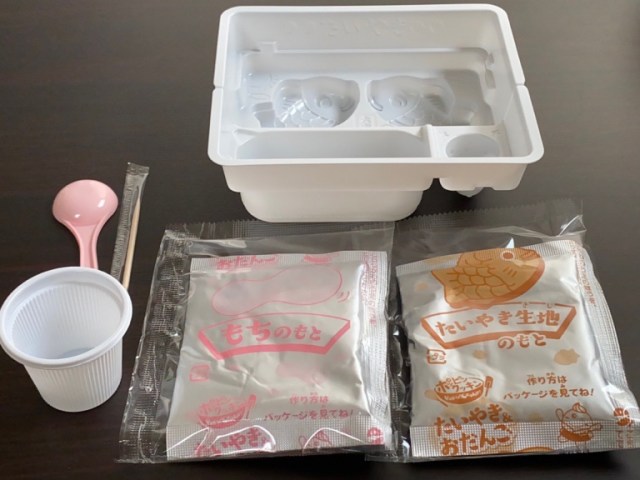

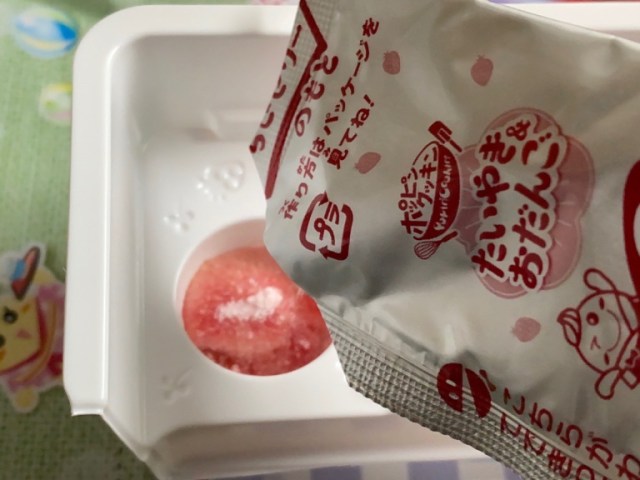
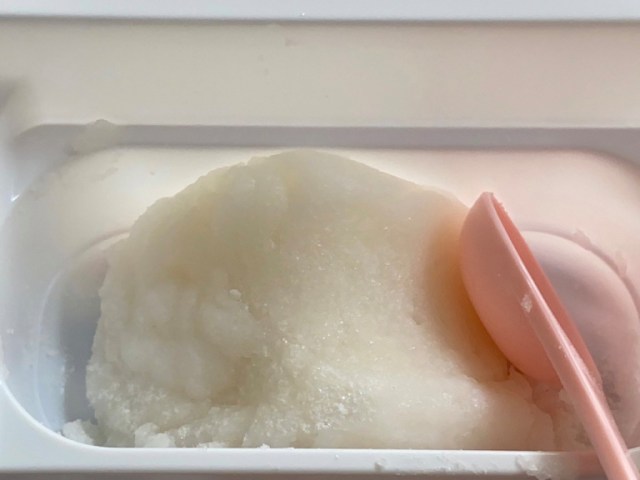
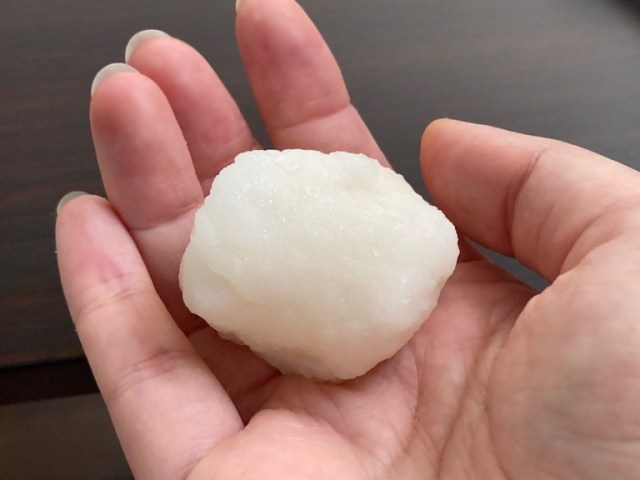
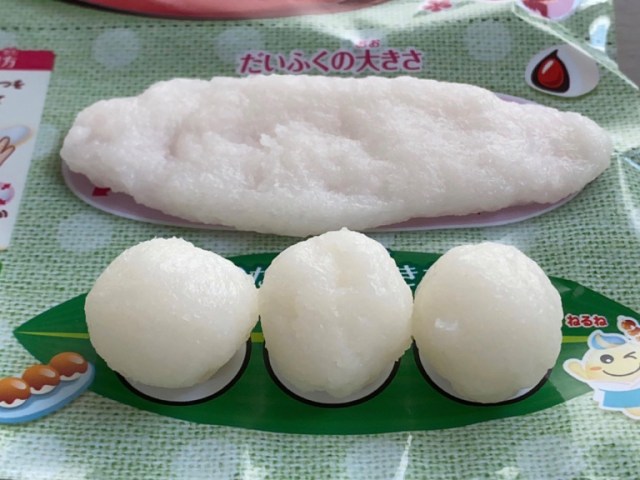
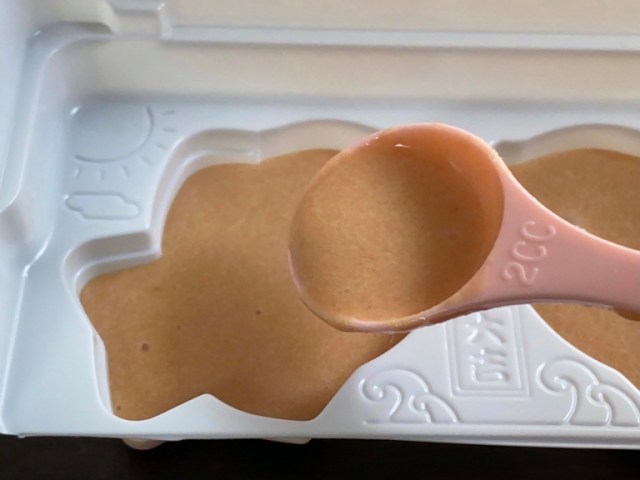
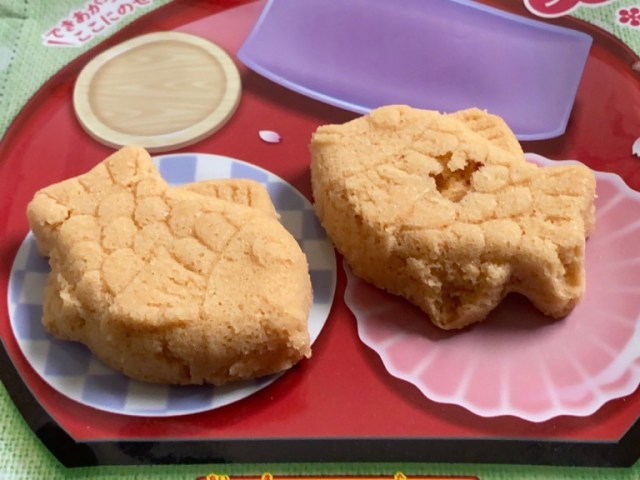
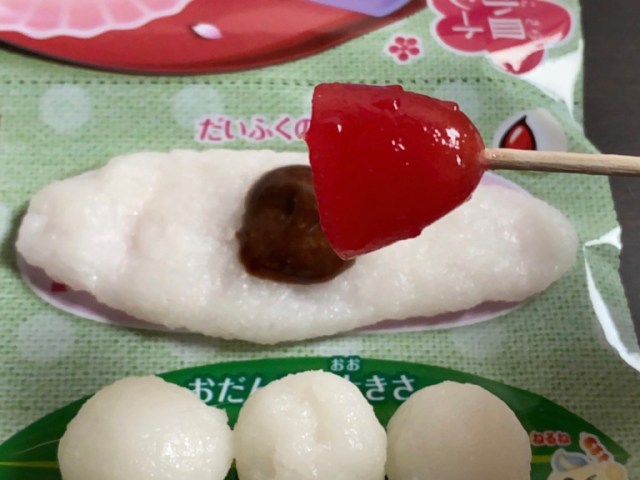
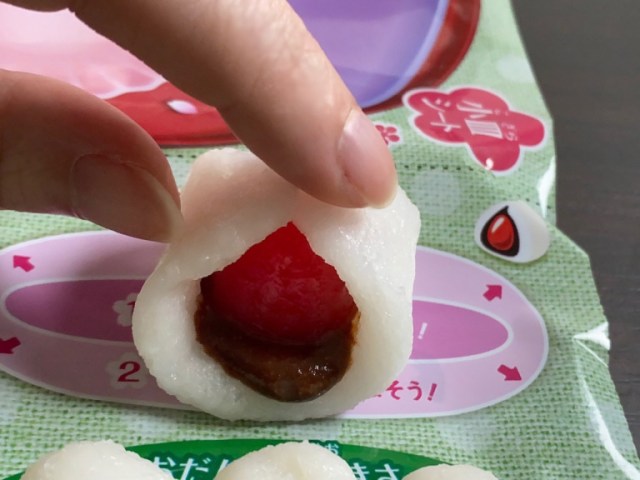
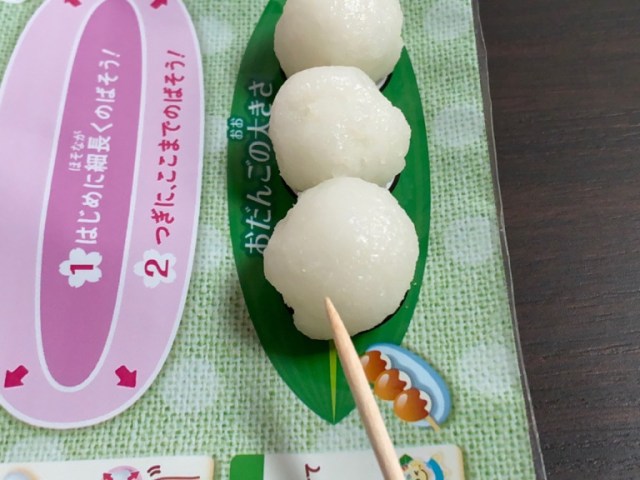
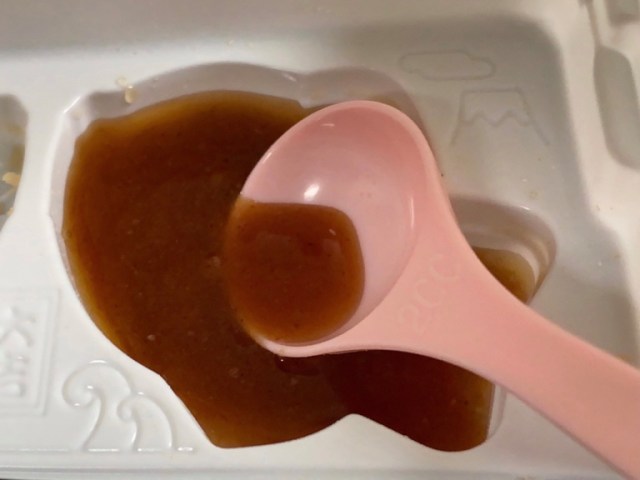
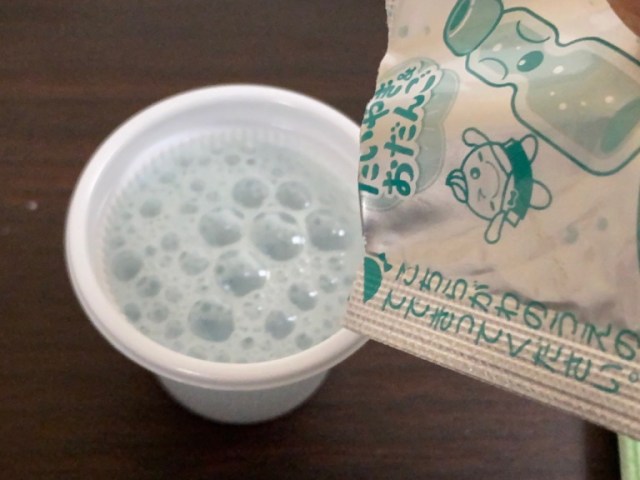
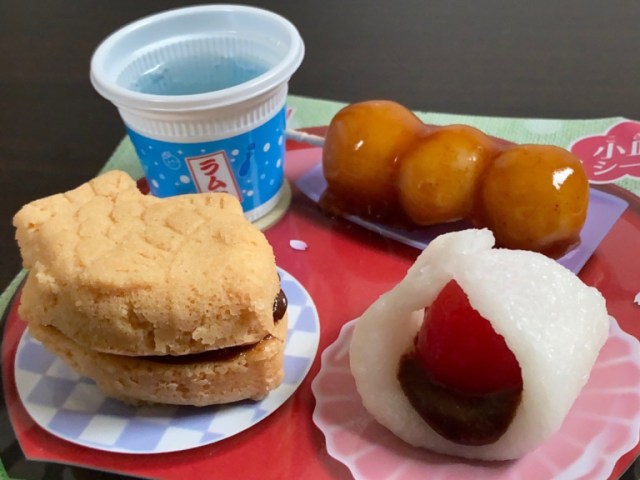
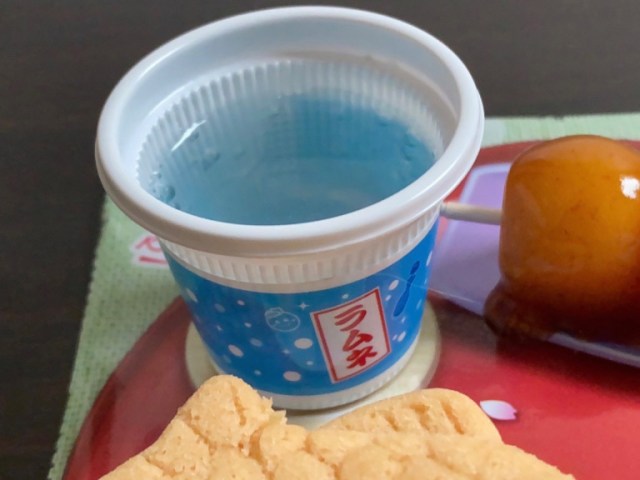
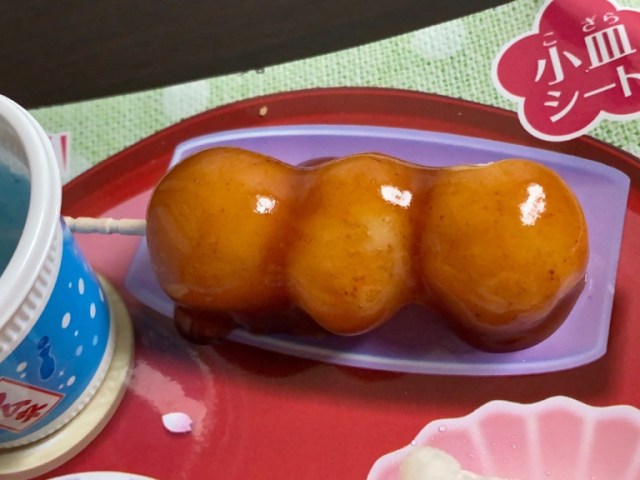
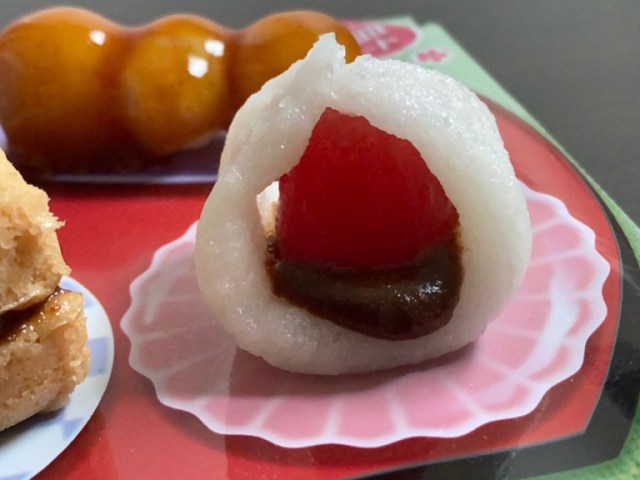
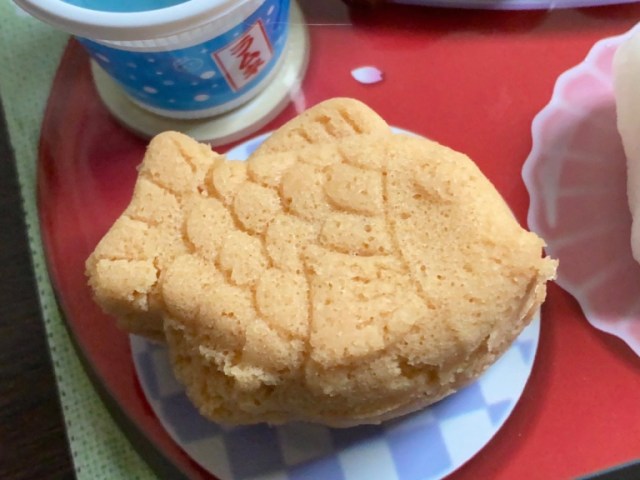
 Studio Ghibli serves up My Neighbour Totoro with a side of traditional Japanese wagashi sweets
Studio Ghibli serves up My Neighbour Totoro with a side of traditional Japanese wagashi sweets Fruit daifuku – A Japanese mochi dessert that’s simple to make and awesome to experiment with
Fruit daifuku – A Japanese mochi dessert that’s simple to make and awesome to experiment with Eight great Japanese sweets for celebrating Wagashi Day (or just for celebrating today)!
Eight great Japanese sweets for celebrating Wagashi Day (or just for celebrating today)! Michelin-approved Japanese chef teaches us two gourmet-standard dishes using ice cream and toast
Michelin-approved Japanese chef teaches us two gourmet-standard dishes using ice cream and toast How many do you know? 12 delicious foods in Japanese supermarkets and convenience stores
How many do you know? 12 delicious foods in Japanese supermarkets and convenience stores Hayao Miyazaki says Happy New Year to Studio Ghibli fans with new art for Year of the Horse
Hayao Miyazaki says Happy New Year to Studio Ghibli fans with new art for Year of the Horse We revisited Sweets Paradise after a decade to see if Japan’s dessert buffet still delivers
We revisited Sweets Paradise after a decade to see if Japan’s dessert buffet still delivers 7-Eleven Japan now has two tiers of salmon rice balls, but is the new, cheaper one any good?【Taste test】
7-Eleven Japan now has two tiers of salmon rice balls, but is the new, cheaper one any good?【Taste test】 Did we strike gold or strike out with this rooftop beer garden on top of a Tokyo parking garage?
Did we strike gold or strike out with this rooftop beer garden on top of a Tokyo parking garage? This ‘Rock Climbing’ ramen will make a man out of you!
This ‘Rock Climbing’ ramen will make a man out of you! Enter the Upside Down from Tokyo — we visit the Stranger Things pop-up cafe in Shibuya
Enter the Upside Down from Tokyo — we visit the Stranger Things pop-up cafe in Shibuya Japan’s greatest anime voice actress, one of its most popular bands team up in beautiful ramen ad
Japan’s greatest anime voice actress, one of its most popular bands team up in beautiful ramen ad Hello Kitty Choco Egg figures are an adorable trip through three periods of Japanese pop culture【Pics】
Hello Kitty Choco Egg figures are an adorable trip through three periods of Japanese pop culture【Pics】 Japan’s oldest largetooth sawfish in captivity back on display in Mie Prefecture
Japan’s oldest largetooth sawfish in captivity back on display in Mie Prefecture How to make a McDonald’s Ramune milkshake at home
How to make a McDonald’s Ramune milkshake at home Starbucks Japan ready to get Year of the Horse started with adorable drinkware and plushies【Pics】
Starbucks Japan ready to get Year of the Horse started with adorable drinkware and plushies【Pics】 7-Eleven Japan’s ramen-cooking robot whipped us up a bowl of noodles【Taste test】
7-Eleven Japan’s ramen-cooking robot whipped us up a bowl of noodles【Taste test】 Cyberpunk anime meets traditional culture in Ghost in the Shell gold leaf Japanese changing screens
Cyberpunk anime meets traditional culture in Ghost in the Shell gold leaf Japanese changing screens 7 great places to see Mt. Fuji from without having to climb it
7 great places to see Mt. Fuji from without having to climb it Japan’s otoshidama tradition of giving kids money at New Year’s gets a social welfare upgrade
Japan’s otoshidama tradition of giving kids money at New Year’s gets a social welfare upgrade We found possibly the quietest Japanese-style hotel in Tokyo’s bustling Shinjuku district
We found possibly the quietest Japanese-style hotel in Tokyo’s bustling Shinjuku district Lacquerware supplier to emperor of Japan and Pokémon team up for new tableware
Lacquerware supplier to emperor of Japan and Pokémon team up for new tableware Sumo Sanrio! Hello Kitty and pals team up with Japan Sumo Association for new merch【Pics】
Sumo Sanrio! Hello Kitty and pals team up with Japan Sumo Association for new merch【Pics】 Can a dirty butthole make you filthy rich in Japan? We’re starting a New Year’s lottery experiment
Can a dirty butthole make you filthy rich in Japan? We’re starting a New Year’s lottery experiment 7-Eleven Japan starts new temporary luggage storage service in over 300 branches
7-Eleven Japan starts new temporary luggage storage service in over 300 branches Disillusionment at Tsukiji’s tourist-target prices led us to a great ramen restaurant in Tokyo
Disillusionment at Tsukiji’s tourist-target prices led us to a great ramen restaurant in Tokyo Starbucks teams up with 166-year-old Kyoto doll maker for Year of the Horse decorations【Photos】
Starbucks teams up with 166-year-old Kyoto doll maker for Year of the Horse decorations【Photos】 Tokyo considering law requiring more trash cans following litter increase in heavily touristed area
Tokyo considering law requiring more trash cans following litter increase in heavily touristed area Tokyo’s Tsukiji sushi neighborhood asks tour groups to stay away for the rest of the month
Tokyo’s Tsukiji sushi neighborhood asks tour groups to stay away for the rest of the month Nintendo’s Kirby now delivering orders at Kura Sushi restaurants, but not in Japan
Nintendo’s Kirby now delivering orders at Kura Sushi restaurants, but not in Japan Tokyo event lets you travel back in time, for free, to celebrate 100 years since Showa era start
Tokyo event lets you travel back in time, for free, to celebrate 100 years since Showa era start Sanrio theme park in Japan announces plans to expand into a Sanrio resort
Sanrio theme park in Japan announces plans to expand into a Sanrio resort Japan may add Japanese language proficiency, lifestyle classes to permanent foreign resident requirements
Japan may add Japanese language proficiency, lifestyle classes to permanent foreign resident requirements Survey asks foreign tourists what bothered them in Japan, more than half gave same answer
Survey asks foreign tourists what bothered them in Japan, more than half gave same answer Japan’s human washing machines will go on sale to general public, demos to be held in Tokyo
Japan’s human washing machines will go on sale to general public, demos to be held in Tokyo Japan’s deadliest food claims more victims, but why do people keep eating it for New Year’s?
Japan’s deadliest food claims more victims, but why do people keep eating it for New Year’s? We deeply regret going into this tunnel on our walk in the mountains of Japan
We deeply regret going into this tunnel on our walk in the mountains of Japan Studio Ghibli releases Kodama forest spirits from Princess Mononoke to light up your home
Studio Ghibli releases Kodama forest spirits from Princess Mononoke to light up your home Major Japanese hotel chain says reservations via overseas booking sites may not be valid
Major Japanese hotel chain says reservations via overseas booking sites may not be valid Put sesame oil in your coffee? Japanese maker says it’s the best way to start your day【Taste test】
Put sesame oil in your coffee? Japanese maker says it’s the best way to start your day【Taste test】 No more using real katana for tourism activities, Japan’s National Police Agency says
No more using real katana for tourism activities, Japan’s National Police Agency says Starbucks Japan reveals new sakura drinkware collection, inspired by evening cherry blossoms
Starbucks Japan reveals new sakura drinkware collection, inspired by evening cherry blossoms Updated cherry blossom forecast shows extra-long sakura season for Japan this year
Updated cherry blossom forecast shows extra-long sakura season for Japan this year
Leave a Reply